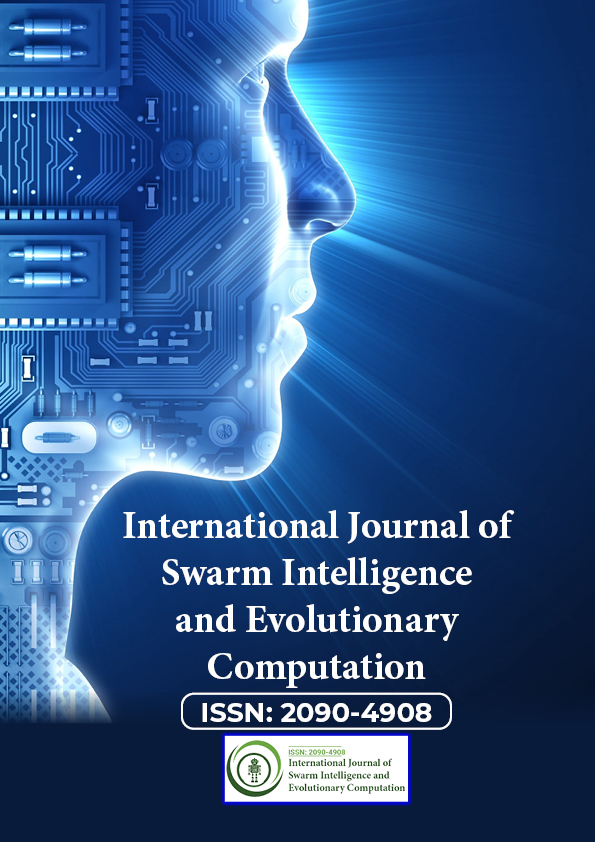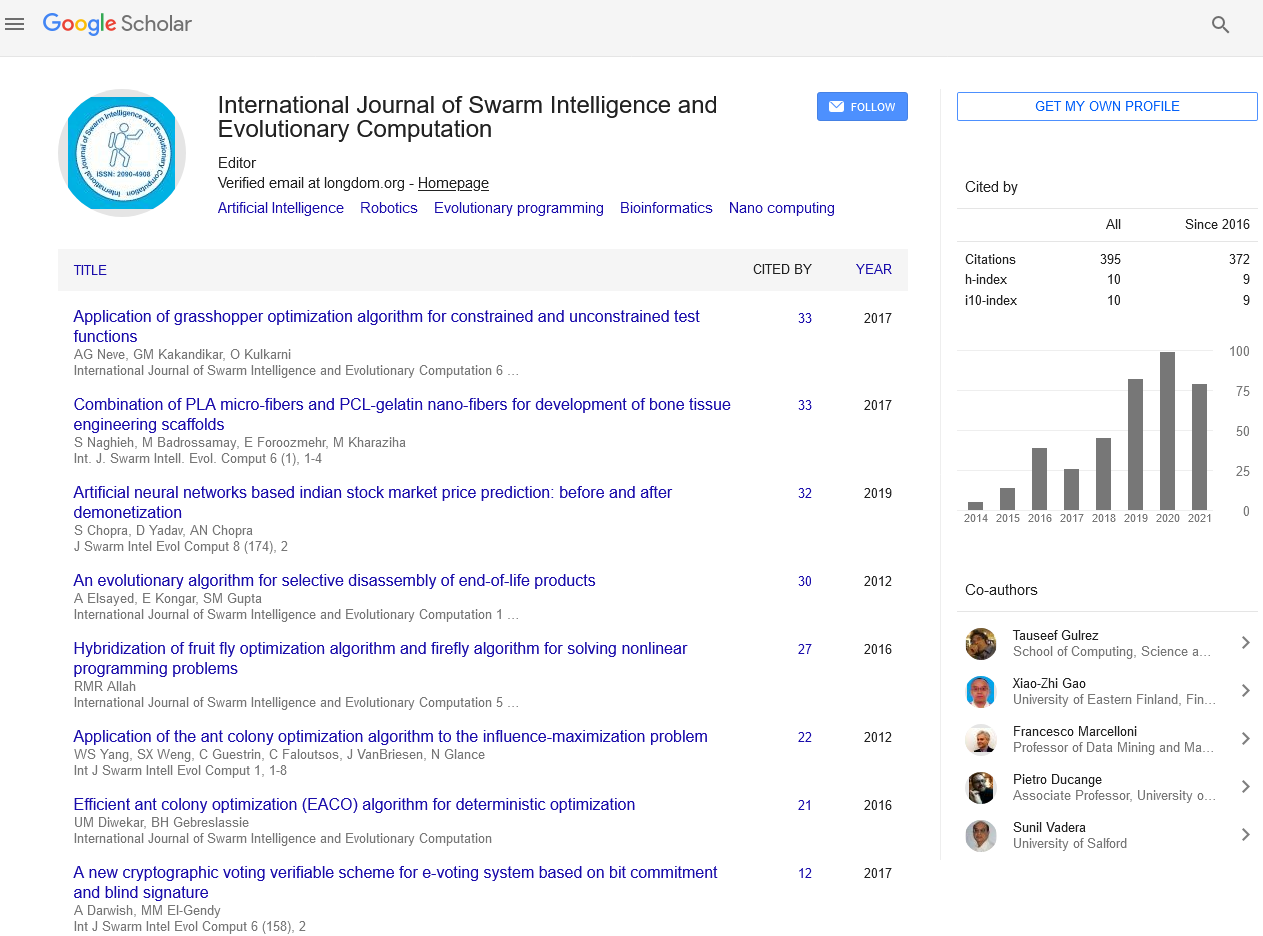Indexed In
- Genamics JournalSeek
- RefSeek
- Hamdard University
- EBSCO A-Z
- OCLC- WorldCat
- Publons
- Euro Pub
- Google Scholar
Useful Links
Share This Page
Journal Flyer

Open Access Journals
- Agri and Aquaculture
- Biochemistry
- Bioinformatics & Systems Biology
- Business & Management
- Chemistry
- Clinical Sciences
- Engineering
- Food & Nutrition
- General Science
- Genetics & Molecular Biology
- Immunology & Microbiology
- Medical Sciences
- Neuroscience & Psychology
- Nursing & Health Care
- Pharmaceutical Sciences
Commentary - (2024) Volume 13, Issue 3
Swarm Behavior and Evolutionary Algorithms: Future of Nature-Inspired Computing
Glenn Richards*Received: 26-Apr-2024, Manuscript No. SIEC-24-25855; Editor assigned: 29-Apr-2024, Pre QC No. SIEC-24-25855 (PQ); Reviewed: 14-May-2024, QC No. SIEC-24-25855; Revised: 21-May-2024, Manuscript No. SIEC-24-25855 (R); Published: 29-May-2024, DOI: 10.35248/2090-4908.24.13.371
Description
Nature-inspired computation patterns are algorithms and computational models inspired by natural processes and systems. These models enhace the principles of evolution, swarm intelligence, and other natural phenomena to solve complex problems in optimization, machine learning, and artificial intelligence.
Key nature-inspired computation paradigms
Nature-inspired computation paradigms include:
Genetic Algorithms (GAs): Genetic algorithms are inspired by the process of natural selection. They operate by encoding potential solutions to a problem as chromosomes and applying genetic operators such as selection, crossover, and mutation to evolve these solutions over successive generations. GAs are particularly effective for optimization problems with large search spaces.
Evolutionary Programming (EP): Similar to genetic algorithms, evolutionary programming focuses on the evolution of behavioral models. It primarily uses mutation as the operator to introduce variations, making it suitable for continuous optimization problems. EP emphasizes the evolution of strategies rather than specific solutions.
Particle Swarm Optimization (PSO): Particle swarm optimization mimics the social behavior of birds flocking or fish schooling. In PSO, a population of particles (potential solutions) moves through the solution space, influenced by their own bestknown position and the best-known positions of their neighbors. This collaboration helps the swarm converge on optimal solutions efficiently.
Ant Colony Optimization (ACO): Ant colony optimization is inspired by the foraging behavior of ants, which use pheromone trails to communicate and find the shortest paths to food sources. In ACO, virtual pheromones are deposited by artificial ants to direct succeeding ants in solving optimisation issues, hence improving the solutions over time.
Artificial Immune Systems (AIS): Artificial immune systems draw inspiration from the human immune system’s ability to recognize and eliminate pathogens. AIS algorithms use mechanisms such as clonal selection, immune network theory, and negative selection to detect anomalies and optimize solutions, finding applications in areas like network security and fault detection.
Artificial Neural Networks (ANNs): Artificial neural networks are inspired by the structure and function of the human brain. ANNs consist of interconnected nodes (neurons) that process information and learn patterns through training. They are widely used in machine learning tasks such as classification, regression, and image recognition.
Applications of nature-inspired computation
Nature-inspired computation applications are:
Optimization: Nature-inspired algorithms are widely used for optimization problems in engineering, economics, logistics, and more. Examples include designing efficient networks, optimizing supply chains, and tuning hyper-parameters in machine learning models.
Machine learning and data mining: These models enhance machine learning algorithms, improve feature selection, and optimize clustering and classification tasks. Neural networks and evolutionary algorithms are particularly prominent in this domain.
Robotics and autonomous systems: Swarm robotics, inspired by social insects, employ collective behaviors for tasks like exploration, mapping, and disaster response. Evolutionary robotics uses evolutionary principles to develop adaptive robotic systems.
Bioinformatics and computational biology: Nature-inspired algorithms are applied to sequence alignment, protein folding, and understanding genetic regulatory networks. They help in modeling complex biological processes and discovering new drugs.
Challenges and future directions
Despite their successes, nature-inspired computation paradigms face several challenges. These include:
Scalability: Ensuring that algorithms perform well on large-scale problems.
Parameter tuning: Determining the optimal settings for algorithm parameters to achieve the best performance.
Hybrid approaches: Integrating multiple patterns to enhance their combined strengths.
Understanding and interpretability: Improving the transparency and interpretability of these algorithms to facilitate their adoption in critical applications.
Future research is likely to focus on developing more sophisticated hybrid approaches that combine different natureinspired models and other computational techniques, such as machine learning and quantum computing. Additionally, there is a growing interest in creating adaptive algorithms that can dynamically adjust their parameters and strategies in response to changing environments and problem landscapes.
Conclusion
Nature-inspired computation models offer powerful tools for solving complex problems across various domains. By mimicking the principles of natural evolution, social behavior, and biological processes, these algorithms achieve strong and flexible solutions. As research progresses, these patterns will continue to evolve, driving advancements in optimization, machine learning, and artificial intelligence. Through innovation and interdisciplinary collaboration, nature-inspired computation will remain at the forefront of computational science and engineering.
Citation: Richards G (2024) Swarm Behavior and Evolutionary Algorithms: Future of Nature-Inspired Computing. Int J Swarm Evol Comput. 13:371.
Copyright: © 2024 Richards G. This is an open-access article distributed under the terms of the Creative Commons Attribution License, which permits unrestricted use, distribution, and reproduction in any medium, provided the original author and source are credited.


